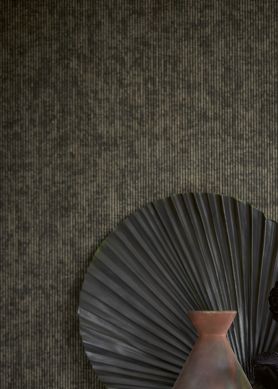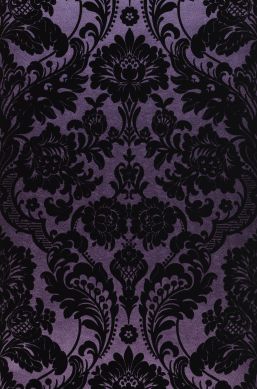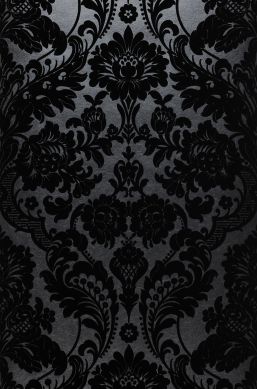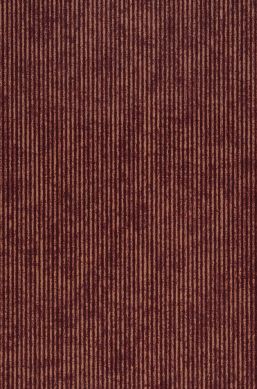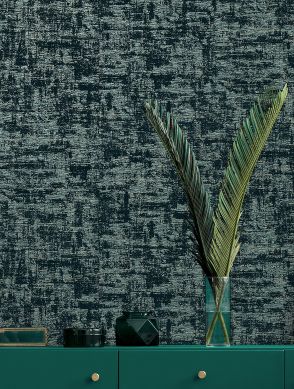Flock Wallpaper
Flock wallpaper: The Guide
Enjoy life with all your senses! Flock wallpapers with a velvety-soft surface invite us to feel and caress them, they create a warming feeling of security and safety. They originated in the 18th century and were made exclusively for members of the high nobility. Thanks to fantastic colour combinations, they create a harmonious overall picture on the wall, giving the room a very noticeable touch of elegance. In addition to their luxurious and three-dimensional appearance, flock and velour wallpapers also have very practical and functional properties. They absorb sound, insulate against cold or heat and regulate the humidity in the room.
Table of Contents
- What is flock wallpaper?
- How is flock wallpaper produced?
- What are the most common colours of flock and velvet wallpaper?
- How are the colours on flocked wallpaper arranged?
- Which classic patterns are popular for flock wallpaper?
- Which modern designs and vintage patterns are popular for flock wallpapers?
- What should be considered when hanging flock and velvet wallpaper?
- How can flock wallpaper be cleaned?
- Why are flock wallpapers so popular?
- What are the special characteristics of flock wallpapers?
- Our tips: Ideas for glamorous flock styles
What is flock wallpaper?
Flock wallpaper consists of a paper or non-woven carrier layer and a surface layer of textile fibres which are glued on under electrostatic charge. This type of wallpaper has existed since the 18th century and is characterised by a velvety feel and three-dimensional patterns.
Paper-based or non-woven wallpaper as carrier material
Paper-based or non-woven wallpaper form the basis for flock wallpapers. The main differences are in the application and removal of the respective wallpaper type. While for wallpapers with paper carriers, the adhesive paste is applied to the back of the wallpaper and a specific soaking time must be adhered to, wallpapers with non-woven carrier layers can be applied dry to the pasted wall without any soaking time. Non-woven wallpapers can be removed dry and without leaving any residue, paper models must be soaked before removal.
Textile fibres glued on under electrostatic charge
The respective carrier material (also called substrate) is completely or partially flocked with textile fibres. As a result of a special finishing process, very short viscose fibres strand up vertically and form a raised, dense and velour-like pile or tuft. Even as far back as ancient Asia, fibres were applied to fabrics by means of adhesive techniques.
Soft, velvety surface
The dense pile material called flock is almost indistinguishable from velvet, both visually and haptically. It invites you to caress it and reinforces the sensual pleasure that is inherent in flock wallpapers. In addition, there are so-called velour wallpapers with a textile surface which is equally tactile.
Three-dimensional patterns
The motifs created by flocking stand out noticeably against the background. The raised surface structure of the motif, known as relief, allows a three-dimensional representation of ornaments and figures. This effect has been popular for more than 300 years.
18th century origins
Based on historical tapestries, the first flock wallpapers were developed in the 18th century as special commissions for the high nobility. The flocking was done by hand with natural wool and silk fibres. Using stencils and stamps, the patterns and motifs were applied in a process of elaborate craftsmanship.
How is flock wallpaper produced?
The manufacturing process of flock wallpaper comprises four important steps. After cutting the flock fibres, a special coating is applied, followed by the application of an adhesive layer and finally the flocking material in an electric field.
Cutting the flock fibres
Special fibres (mostly viscose) are mechanically cut to the correct length which varies between 0.3 and 6 mm. It is also possible to combine different lengths of flock fibre for a special look and feel. The thickness and length of the flock fibres determine whether the flock will be loose and velvety, compact and dense, or pressure-resistant.
Applying coating around fibres
In the next step, the flock fibres are immersed in a water bath to which tannins (vegetable tanning agents) and salts are added. The resulting coating wraps around the fibres like a fine film and is the prerequisite for electrical conductivity after drying. This enables the micro-short flock fibres to stand upright.
Applying the adhesive layer
A layer of suitable adhesive (water- or solvent-based) is then applied to the substrate. Techniques such as brushing, rolling, dipping, spraying, screen or pad printing can be used to create the desired pattern. This can be done to either flock the motif silhouette or over the entire surface. The flock fibres later stick to the areas where adhesive has been applied.
Flocking in an electric field
The last step: Under electric charge, the coated flock fibres are "shot" onto the adhesive layer in large quantities (millions of fibres). Due to the electrostatic charge, they straighten up vertically and bond perfectly with the adhesive. After the adhesive layer has dried, excess fibres can be vacuumed or blown off.
What are the most common colours of flock and velvet wallpaper?
Classic neutral colours such as black, white or grey give flock wallpapers an elegant, modern or sophisticated touch. Red and blue are just as popular because they appear magnificent, majestic and striking.
Red
In the theory of colours, the signal colour red stands for passion and fire, among other things. It's stimulating and, depending on the shade, can be very dominant. Crimson is a favourite for flock wallpapers as it is considered a regal colour which works really well with damask patterns or opulent retro designs. Ruby red and black red are popular darker shades.
Black
Black is mysterious, deep and magical. In combination with silver, gold, white and cream, powerful contrasts are created which serve both modern and classic patterns. Shimmering effects offer additional highlights. Amongst the most popular black flock wallpapers are those where background and pattern hue are identical and the pattern is created by the relief effect.
White
The colour white stands for innocence and purity. Not only does it appear cool and refreshing, but in nuances such as ivory or old white it emphasises the pleasantly soft effect of wallpapers with flock and velvet surfaces. In combination with black and grey, white creates sophisticated contrasts on the wall and in the room.
Blue
Blue is the colour of sky and sea, it is associated with the supernatural and has a calming effect. While light and blue-green nuances exude a maritime flair, dark hues stand for sophistication and regalness. Blue stylishly accentuates baroque-style or damask patterns or floral motifs and can create a pleasant tension.
Grey
The mixture of black and white works with strong as well as muted colours and of course with black and white. As a result, grey is a popular combination colour, it can emphasise all other colours and visually highlight flock patterns. Shades like light grey, silver grey and ice grey are top of the list.
How are the colours on flocked wallpaper arranged?
Basic and pattern colours are arranged in a variety of ways on flocked wallpaper. They can be identical, or the background colour can be different from the pattern colour.
Basic colour and pattern colour are identical
If the background and the pattern colour of the wallpaper are identical, the result is an almost uniform appearance. The flock components can stand out in a discreet or a more striking manner. The background often has a shimmering effect, combining the three-dimensional element with a sophisticated play of light. Black or white flock wallpapers in particular often boast this effect.
Base colour and pattern colour are different
Contrasts of varying intensity are created when the base colour and the pattern colour are different. Bright hues can be mixed with neutral colours or black and white can be combined with silver or other metallic shades. Glitter particles are often added to base or pattern colours for a luxurious touch.
Which classic patterns are popular for flock wallpaper?
Classic pattern shapes traditionally play an important role on velvet wallpaper. Large-scale damask patterns, small-scale flocked patterns and formalised designs with architectural elements are amongst the most popular.
Large-scale damask patterns
Opulent damask patterns and ornaments are usually arranged symmetrically around a vertical axis. They are ideal for large, representative rooms and formal environments. Flock wallpapers in a baroque style frequently look like precious damask fabrics, emphasising their decorative, valuable character.
Small-scale flock patterns
The informal, asymmetrical style of French Rococo is often used as a blueprint for small-scale flocked patterns. There is a wide range of patterns, from simple geometric designs to pretty floral patterns. Delicate flock designs in light colours are suitable for smaller rooms.
Formalised design with architectural elements
To formalise means to "to arrange something according to a fixed structure". In terms of design, it signifies that a pattern is based on a certain (e.g. geometric) form. Architectural elements from different periods and styles can also be included. Typical decorative patterns from the 17th century with geometrically constructed patterns and ornaments are common, too.
Chinoiserie designs
The Chinoiserie style represents a European art movement of the late 17th and 18th century based on Chinese art. Chinese landscape paintings, pagodas, Asian sceneries & symbols as well as floral patterns are artistically created in the manner of lacquer painting or ink drawing as decoration for fabrics, wallpapers, porcelain and furniture.
Which modern designs and vintage patterns are popular for flock wallpapers?
For velour wallpapers, modern and vintage designs follow the motto: exceptional, grandiose, with a tendency towards extravagance. Luxurious floral designs, glamorous Art Deco patterns and opulent 70s motifs are right at the top of the popularity scale.
Luxurious floral designs
Elaborate tendrils and leaf ornaments, bulging bouquets, imaginative flowers or abstract floral art with sophisticated colour contrasts combine the beauty of nature with the dynamic movement of the velvet structure. Shimmering backgrounds and colours such as black, silver, gold beige, may-green or purple underline the luxurious aspect.
Glamorous Art Deco patterns
Long live the Golden Twenties with their stylish décors which provide irresistible glamour for tactile flock wallpapers. Symmetrical geometry, layered shapes and aerodynamic curves are typical pattern elements. Metallic base colours such as chrome, copper or gold are given a dynamic of their own which the flocking adapts perfectly to.
Opulent 70s motifs
Futuristic, oversized geometry (especially circles), psychedelic Op Art and stylised love-and-peace power flowers are the driving forces on vintage wallpapers in the Seventies look. Strong and wild colours rich in contrasts reflect the sought-after hippie vibe which is complemented by the velvety feel of the flock wallpaper.
What should be considered when hanging flock and velvet wallpaper?
Due to their delicate surface, putting up flock and velvet wallpapers requires a bit of care and preparation. Very little pressure, clean hands, soft tools, putting paper between tools and wallpaper, immediate removal of fresh paste stains & continuous tool cleaning are amongst some of the most useful tips.
Work with little pressure
The smoothing process should not be taken too literally with flock wallpapers. Make sure to apply only as much paste as necessary to the wallpaper or wall (depending on the type of wallpaper used). It is of essential importance to avoid that any paste ends up on the wallpaper surface as this would damage the flock elements. Work should proceed quickly and only with moderate pressure so that the flock is not flattened.
Make sure that your hands are clean
When it comes to handling velvet wallpaper, freshly washed, grease-free and dry hands are of the utmost importance. Otherwise, dirt or paste residues on the hands will transfer to the flock and leave behind stains that cannot be removed. Thin cotton gloves are ideal to avoid any of these issues. They should also be changed regularly during the hanging process.
Choose soft tools
To even out the seam transitions between individual lengths of flock wallpaper, seam rollers with a roller made of foam rubber or felt are best suited. Here, too, it is important to use as little pressure on the surface as possible. Clean the foam rubber roll regularly to avoid any paste damaging the flock.
Place a layer of paper between tool and wallpaper
When smoothing out the wallpaper on the wall, silk paper or thin white paper should be placed between the surface of the wallpaper and the wallpapering brush to protect the flock. This way, the flock is not directly touched by the brush and won't be damaged. It is important to work particularly carefully as the wallpaper surface can no longer be seen.
Remove fresh paste stains immediately
If paste stains occur despite all precautionary measures, they can be carefully removed whilst still fresh. The damp stain is carefully dabbed off with a dry, soft and lint-free cloth. Make sure that you do not rub in the paste. This would spread it over a larger area and potentially destroy flock fibres.
Clean tools continuously
To achieve the desired result, work should be carried out with clean, grease- and paste-free tools. This might require repeated cleaning of certain tools. Otherwise the flock could be damaged by the wallpapering paste and the stains cannot be removed. Be sure to change the cleaning water in the bucket regularly.
How can flock wallpaper be cleaned?
Wallpapers with a flock surface are more sensitive than other types. Cleaning with a damp cloth is not an option. If cleaning with a dry cloth is required, a test should first be carried out in an inconspicuous area. Dust can be removed with an antistatic cloth.
Do not clean by brushing off
The flock fibres are applied to the wallpaper with a special adhesive. They cannot withstand dry cleaning with brushes (even soft ones). On the contrary: by brushing, the fibres are removed. In addition, brushing may cause scratches in the flock-free areas of the wallpaper.
Remove dust with an antistatic cloth
When removing dust from flock wallpaper, always use a soft, dry microfibre cloth and gently move it across the walls. As the short textile fibres have been treated with an electrostatic charge, you should use antistatic cloths which should be attached to a holder with a telescopic handle. This way you can work comfortably and easily, avoiding too much pressure.
First, test in a less visible place
For flock wallpapers, cleaning with a damp cloth is not an option. They are also unsuitable for use in damp rooms such as kitchens or bathrooms. Even when cleaning with a soft dry cloth, you should first test this on a less conspicuous spot to see how the flock reacts. Depending on environmental influences over the years, the adhesive might not be able to hold the flock fibres as well as was the case originally.
Why are flock wallpapers so popular?
Flock and velour wallpapers are synonymous with splendour and glamour. They are considered the upper nobility's extravagant wall covering of choice. Their fascinating play of light and shade fills the room with sensual movement.
Synonymous with splendour and elegance
The velvety structure of these special wallpaper models is reminiscent of luxurious wall coverings made of precious fabrics, creating a magnificent and yet comfortable ambience. In addition, the fluffy elements exude a cosy warmth. Flock wallpapers are less suitable for rooms with heavy public traffic, as the delicate fibres could be damaged accidentally.
Fascinating play of light and shade
The high-low structure which results from the upright flock fibres on a flat underground creates gentle movement in the room and gives the pattern motif a three-dimensional effect. Together with carefully selected colours as well as shimmering and glossy effects, fascinating plays of light and shadow are created which attract the eyes and invite to touch.
Extravagant wall coverings of the baroque nobility
The aristocracy of Baroque times set a monument to opulent, luxurious interior design with exquisite flocked wallpaper. To this day, the classic designs of the early 18th century have survived as a kind of gold standard for good taste that transcends all fashions and trends. This kind of décor provides stylish and durable wall decoration.
What are the special characteristics of flock wallpapers?
In addition to their velvety feel which creates a sense of well-being and enjoyment, flock wallpapers have fabulous functional properties. They are sound-absorbing, regulate air humidity, have an insulating effect against cold and heat and great light resistance.
Sound-absorbing, muting noise
A densely flocked textile surface absorbs sound and noise, which is particularly useful in rented apartments with thin walls. Sound waves are absorbed by the velvet structure of the wallpaper; the acoustic reflection on smooth walls is significantly reduced. In addition, vibrations are also less noticeable.
Regulation of air humidity
Breathable carrier and surface materials ensure the absorption and release of moisture from the ambient air. This prevents condensation which in turn prevents moisture-related issues such as mould from developing under the wallpaper. Flock wallpapers have no negative impact on our health.
Insulating effect against cold and heat
Flocked wallpaper insulates, to a certain extent, against cold and heat. This insulating effect is particularly effective with plain-coloured velvet wallpapers without patterns, where velvet fabric is laminated onto a non-woven wallpaper carrier layer. Temperature differences can be compensated noticeably. The reason for this positive effect is the air inclusion between the millions of flock fibres on the wallpaper surface.
Good light resistance
Wallpaper models with flock elements generally boast good light resistance. This means that direct sunlight does not cause colour changes. Even intense colours shine with lasting brilliance. Nevertheless, they are unsuitable for outdoor areas such as balconies and verandas, as weather influences can damage or destroy the wallpaper.
Our tips: Ideas for glamorous flock styles
- Majestic finish at the ceiling transition: If walls are decorated with flock wallpaper, decorative stucco elements provides a stylish finish at the transition to the ceiling. Classical or floral motifs set a particularly elegant corner point which emphasises the wallpaper.
- A glamorous place for the royal class: Furnish a cosy fireplace room (the fireplace doesn't have to be functional) with antique velvet furniture, a Victorian mirror and a Baroque-style flock wallpaper in dark shades. Furniture and fireplace should be in contrasting but harmonious colours.
- Integrate doors in a tasteful manner: Wallpaper the doors with your chosen velvet wallpaper to make it "merge" with the matching wall surfaces. In historical castles, the doors are often integrated into the wall design by using fabric, silk wallpaper or decorative painting. The wooden surface should be sanded before wallpapering to ensure adhesion.
- Notebook in a velvety robe: Notes, sketches, ideas or appointments are often jotted down in notebooks. Embellish the cover with left-over flock wallpaper cut-offs, because they are far too good to just throw away. Whenever you pick up your notebook, you may give in to the desire to caress it.






